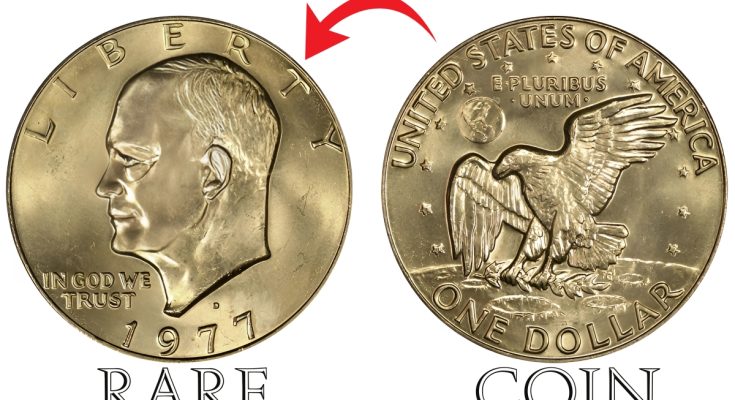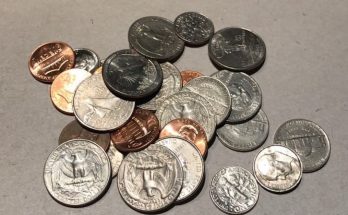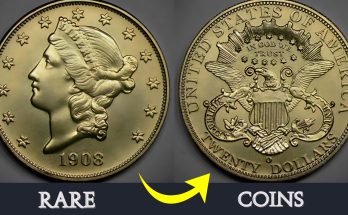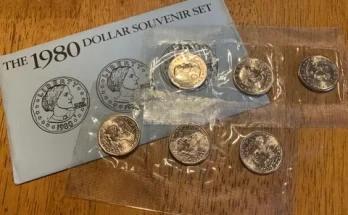Clad Eisenhower Dollar The jingle of coins in my grandfather’s pocket always fascinated me as a child. Among his collection, the large Eisenhower dollars stood out – heavy, substantial pieces of American history that seemed to carry more than just monetary value. These distinctive coins, minted for just eight years between 1971 and 1978, represent a fascinating chapter in U.S. numismatic history that often gets overshadowed by their more precious silver counterparts.
The Birth of a Modern Clad Eisenhower Dollar
Honoring a President and a Historic Achievement
When Dwight D. Eisenhower passed away in March 1969, the nation mourned the loss of both a respected military leader and a popular two-term president. Around the same time, America was captivated by the historic Apollo 11 moon landing. These two significant events converged to inspire the creation of a new dollar coin that would honor both Eisenhower’s legacy and mankind’s greatest technological achievement.
Representative Bob Casey of Texas introduced legislation for a new dollar coin featuring Eisenhower on the obverse and an eagle landing on the moon on the reverse – a perfect marriage of traditional American symbolism with contemporary achievement. After political wrangling over the coin’s composition, Congress finally authorized the production of the new dollar in December 1970.
Frank Gasparro, the U.S. Mint’s Chief Engraver, designed both sides of the coin. His obverse portrayed a dignified profile of Eisenhower based on his presidential portrait. For the reverse, Gasparro adapted the Apollo 11 mission patch showing an eagle landing on the lunar surface with Earth visible in the distance. The result was a coin that simultaneously looked back at American tradition while celebrating the nation’s technological future.
The Clad Composition Controversy
One of the most interesting aspects of the Eisenhower dollar’s story involves its composition. By 1970, silver prices had risen significantly, making the traditional 90% silver dollar economically impractical for general circulation. After considerable debate, Congress compromised: the general circulation Eisenhower dollars would be produced in a copper-nickel clad composition (the same as dimes and quarters today), while a limited number of 40% silver versions would be struck for collectors.
This decision created two distinct categories of Eisenhower dollars. The clad business strikes, made for everyday transactions, contained no precious metal and were composed of an outer layer of 75% copper and 25% nickel bonded to a pure copper core. These are the pieces I’ll focus on in this article – the everyday workhorses that circulated, albeit briefly, in American commerce.
Collecting the Clad Eisenhower Dollar
Rarity Despite High Mintages
Looking at the raw mintage figures, one might assume clad Eisenhower dollars are common coins. The Philadelphia Mint (no mint mark) and Denver Mint (D mint mark) produced hundreds of millions of these coins for circulation between 1971 and 1978. However, appearances can be deceiving in numismatics.
Despite these high production numbers, truly uncirculated specimens in pristine condition have become surprisingly elusive. Several factors contributed to this paradox:
-
Many Eisenhower dollars were immediately set aside by the public as souvenirs or novelty items rather than being spent.
-
Casino use in Nevada and other gambling locations subjected many coins to heavy handling and bag marks.
-
The large size of the coin (38.1mm diameter) made it vulnerable to surface damage even in normal handling.
-
The copper-nickel clad composition shows wear and contact marks more readily than silver coins.
As a result, coins grading MS-65 or higher on the Sheldon scale are much scarcer than mintage figures would suggest. Finding a clad Eisenhower with minimal bag marks, strong strike, and good luster has become increasingly challenging for today’s collectors.
Year-by-Year Analysis and Key Dates
While no clad Eisenhower dollars can be considered truly rare by mintage, certain issues present particular challenges for collectors seeking high-grade specimens:
1971 (Philadelphia – No Mint Mark): With over 47 million minted, this inaugural issue should be common. However, many were poorly struck with weak details on the eagle’s feathers and Eisenhower’s hair. Finding well-struck examples remains challenging.
1971-D (Denver): The Denver mint produced over 68 million examples, but like its Philadelphia counterpart, strike quality was inconsistent. Many show weakness in the central details.
1972 (Philadelphia): This year produced the most famous variety in the series – the 1972 Type 2 reverse, where the earth appears to have islands or continents not present on the Type 1 and Type 3 designs. These distinct design differences resulted from a revision of the reverse die that was only used briefly.
1972-D (Denver): With over 92 million struck, this is the highest mintage of the series but suffers from the same quality control issues as other early dates.
1973 (Philadelphia): Strike quality improved slightly, but many examples show weakness on the reverse design.
1973-D (Denver): Over 28 million minted, with somewhat better overall quality than earlier issues.
1974 (Philadelphia): Nearly 28 million minted, with improved strike quality over previous years.
1974-D (Denver): With over 45 million struck, these are relatively common but typically better struck than earlier Denver issues.
1976 (Philadelphia) Bicentennial: Featuring a special reverse design by Dennis Williams depicting the Liberty Bell superimposed over the moon to celebrate America’s 200th birthday. These were struck in 1975 and 1976 but all bear the dual date “1776-1976.”
1976-D (Denver) Bicentennial: Like its Philadelphia counterpart, these feature the special Bicentennial reverse and dual date.
1977 (Philadelphia): The regular eagle landing design returned with over 12 million minted.
1977-D (Denver): Nearly 33 million struck, generally well-produced with good strike quality.
1978 (Philadelphia): The final year of Eisenhower dollar production saw about 25 million struck at Philadelphia.
1978-D (Denver): The Denver mint produced over 33 million for the final year, typically with good strike quality.
Market Values and Investment Potential
Current Pricing Trends
In circulated condition, clad Eisenhower dollars generally trade for little more than their face value, often between $1.25 and $2.00 depending on condition. However, the market changes dramatically for pristine uncirculated examples.
As of early 2025, common date Eisenhower dollars in MS-63 condition typically sell for $5-10, while MS-65 examples command $25-45. The real premium comes at the MS-66 and MS-67 levels, where prices can jump significantly:
-
Common dates in MS-66: $75-150
-
Common dates in MS-67: $400-1,000+
-
The rare MS-68 specimen (with only a handful certified by major grading services): $5,000-10,000+
The 1972 Type 2 variety carries the highest premium among circulation strikes, with nice uncirculated examples selling for $50-100 and gems exceeding $500.
Factors Influencing Value
Several factors influence the potential appreciation of clad Eisenhower dollars:
-
Strike Quality: Well-struck examples with full detail on Eisenhower’s hair and the eagle’s feathers command significant premiums.
-
Surface Preservation: Copper-nickel surfaces easily show contact marks and abrasions. Coins with minimal bag marks are highly desirable.
-
Luster: Original mint luster adds significant value, with frosty or prooflike surfaces commanding the highest premiums.
-
Toning: While not as common as on silver coins, attractive natural toning can add value to clad Eisenhower dollars.



